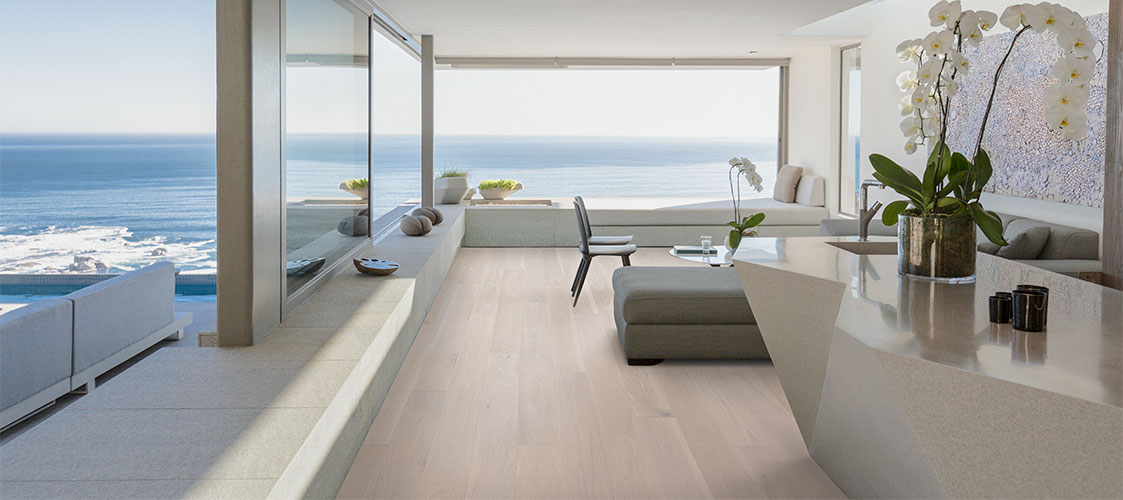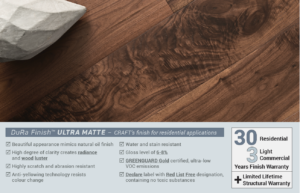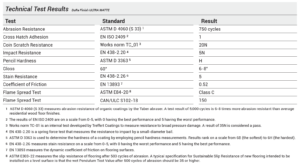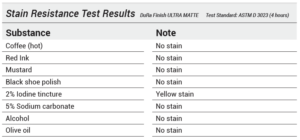DuRa Finish™ Ultra Matte
CRAFT’s finish for residential applications

DuRa Finish™ ULTRA MATTE derives its name from the Durability and Radiance which is perfectly combined to produce the ultimate residential wood flooring finish. Through the application of multiple coats of advanced protective finish in micro-thin layers which perfectly conform to the subtle contours of wood’s natural surface, DuRa Finish™ ULTRA MATTE mimics the look of a natural oil finish, while having the function and performance of a durable UV cured urethane finish.
Download the full PDF document for CRAFT’s DuRa Finish™ ULTRA MATTE here

SUSTAINABILITY CERTIFICATIONS AND REPORTS
Flooring with DuRa Finish™ ULTRA MATTE has been tested for VOC emissions and has achieved GREENGUARD Gold certification. In addition, CRAFT’s floors have achieved a Declare label with a Red List Free designation, indicating that all coatings, stains, fillers and glues used to make CRAFT floors are free of any of the toxic substances commonly found in building products. An extensive Life Cycle Analysis of the environmental impacts that arise from making CRAFT flooring (including the entire finishing process) is captured in a Product Specific, Type III Environmental Product Declaration which has been published and is available as public information. For more information, visit our Planet page.

DuRa Finish™ ULTRA MATTE is a proprietary finishing system that uses water-based coatings in conjunction with technically advanced UV cured polyurethanes which employ macro-molecule cross-linking technology with silicon dioxide and acylated PU resin. These advanced coatings are applied in micro-thin layers, perfectly forming to the subtle contours of the wood’s surface.


Care and Maintenance of a DuRa Finish™ ULTRA MATTE Floor
All CRAFT accessories are finished with the same process as the matching flooring, thus ensuring a comparable appearance in stain colour, gloss level, wearability, etc.
Accessories
In order to get the longest life out of any urethane finished wood floor, it is of utmost importance to follow several important recommendations , which are covered in the CARE AND MAINTENANCE of a CRAFT FLOOR guide, available for download here.
Gloss Level
The target gloss level of DuRa Finish™ ULTRA MATTE is 6-8%, which is similar to that of a natural oil finish. Although it is technically possible to achieve a gloss level below 6%, floors with gloss levels below 6% look dull and lack the luster and depth of a natural oiled floor. Gloss levels above 10% make a floor look shiny and unnatural. A gloss level of 6-8% gives wood beautiful depth and luster while still maintaining the look of natural wood.
Resistance to colour change
All stains, glazing and coatings used to colour and finish a CRAFT floor are formulated to be resistant to UV discoloration such as yellowing, and to maintain colour consistency over time. However, it should be noted that continuous exposure to high levels of UV rays can lead to gradual colour change. For projects with large south-facing windows, it is strongly recommended to utilize UV protection to greatly reduce the possibility of eventual colour change of all interior materials including furniture, artwork and flooring. Aftermarket protective films, such as those made by 3M, are one recommended solution.
Refinishing a DuRa Finish™ ULTRA MATTE Floor
DuRa Finish™ ULTRA MATTE is a hard, abrasion resistant coating that is not easily removed from the surface of wood. It is nonetheless possible for professional wood flooring refinishers to remove the finish by using specialized floor sanding equipment. In the event that the entire finish is removed, in what is known as a “sand and refinish” process, all of the finish, including the stain and the wood’s original texturing will be entirely removed. This process will often remove 1mm or more of the floor’s overall thickness, and is usually only required when the finish is severely degraded, or for when it is required to change the floor’s stain colour or wood texturing. In instances where the surface of the floor is only moderately worn, and the underlying stain remains unaffected, it is often possible to do what is referred to as a “screen and re-coat” whereby new surface coatings are added to the existing finish. It is possible to successfully do a screen and recoat on a floor with DuRa Finish™ ULTRA MATTE, but it is strongly recommended to do isolated testing first before attempting the procedure on an entire floor.
Product End-of-life
Although it is commonly thought that any wood finished with urethane coatings is not possible to recycle, some jurisdictions will accept urethane finished wood for recycling. As per the extensive material declaration through ILFI’s Declare program, and the status of CRAFT’s products as Red List Free, there are no recognized toxic substances in CRAFT’s stains or finishes, and therefore there is no concern about CRAFT products causing environmental contamination at the end of their useful life, upon recycling or disposal.

